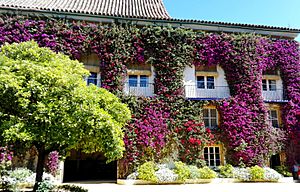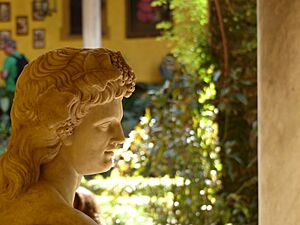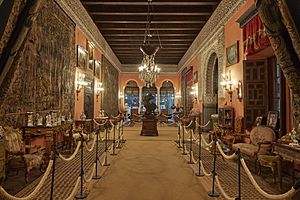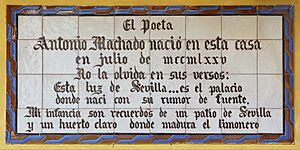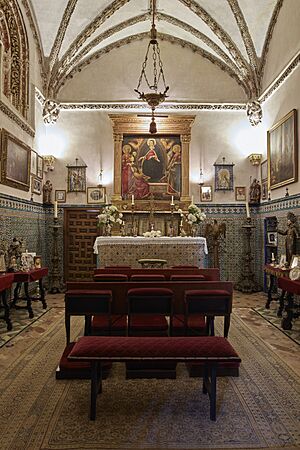Palacio de las Dueñas facts for kids
The Palacio de las Dueñas (sometimes called Casa Palacio de las Dueñas) is a beautiful palace in Seville, Spain. It belongs to the famous House of Alba family. This palace was built in the late 1400s. It mixes different styles like Renaissance, Gothic, and Moorish. It is one of the most important historic homes in Seville, known for its amazing architecture and art.
Many famous people were born here, including the poet Antonio Machado. On October 5, 2011, Cayetana Fitz-James Stuart, 18th Duchess of Alba, who was a very well-known Duchess, got married here for the third time. The palace became a special national monument in Spain on June 3, 1931.
The current Duke of Alba, Carlos Fitz-James Stuart y Martínez de Irujo, decided to open the palace to visitors in 2016. Now, it is one of the most popular places to visit in Seville.
Contents
History of the Palace
The Palacio de las Dueñas was built in the late 1400s. This was a time when Seville was growing and many grand buildings were being constructed, like the Alcazar Real. The Pineda family first built the palace.
In 1496, the Pineda family sold their home to Doña Catalina de Ribera. They needed money to help free a family member who had been captured. After this, the palace was made much bigger. It became a grand Renaissance palace thanks to Fernando Enrique de Ribera and his wife, Doña Inés Portocarrero.
The palace later became part of the House of Alba family through a marriage.
For a time, the palace was home to Lord Holland, who loved Spanish books. The famous poet Antonio Machado lived in the palace when he was a young child. His father worked as a caretaker for the Duke of Alba.
The palace gets its name from a nearby monastery called Santa María de las Dueñas. This monastery was destroyed in 1868. The palace itself was updated a lot in the 1700s and 1800s.
Palace Architecture
The Palacio de las Dueñas has many courtyards and buildings. Its style is a mix of Gothic, Moorish, and Renaissance designs. It also uses local materials like bricks, tiles, and whitewashed walls. This mix of styles makes it similar to other famous buildings in Seville, like the Casa de Pilatos.
Inside the Palace
The palace has long hallways. The main staircase is built under a beautiful curved roof. On the top floor, there is a room with an eight-sided ceiling decorated with gold wooden panels.
Outside the Palace
The main entrance door is in the Mudéjar style, which is a mix of Christian and Islamic art. The palace once had eleven courtyards, nine fountains, and over 100 marble columns! Today, one main courtyard remains. It is surrounded by a gallery with columns. This Andalusian patio, like the one at Casa de Pilatos, is a key part of the palace's outdoor design.
At the entrance, above the main archway, you can see the shield of the Duchy of Alba. It is made of tiles from Seville, dating back to the 1600s or 1700s. The gardens have very special and old plants, including one of the oldest cycas revoluta trees in the world. The amazing bougainvillea flowers covering the facade are also a famous sight at the palace.
Antonio Machado Plaque
There is a special plaque at the palace that honors the poet Antonio Machado. Here is what it says:
| Original text | What it means in English |
|---|---|
| El poeta Antonio Machado nació en esta casa |
The poet Antonio Machado was born in this house |
Gardens and Chapel
The main garden is divided into four parts, a traditional Islamic style. It has tiled paths and a fountain in the center. The lemon trees and fountain in the palace garden were important symbols in Machado's poetry.
Behind the garden, there is another courtyard with arches and white marble columns. An arch on the west side of this courtyard leads to the chapel. This chapel was built in the 1400s. The altar has special tiles with shiny, metallic colors, which were popular in Seville in the 1500s.
It is also believed that Amerigo Vespucci, the explorer, married María Cerezo in this chapel in the early 1500s.
Art Collections
One of the best things about the Palacio de las Dueñas is its huge collection of decorative art. There are 1,425 items! These artworks are protected by law in Andalusia, meaning they cannot be sold and must stay in the palace.
The collection includes many Italian and Spanish paintings from the 1500s and 1600s. You can see works by artists like Jacopo Bassano, Sofonisba Anguissola, and Jusepe de Ribera. There's even a watercolor painting by Jacqueline Kennedy Onassis, who visited the palace in 1960.
The palace also has a great collection of old furniture, ceramics, and other interesting items. You can find sculptures from Ancient Rome and modern artists like Mariano Benlluire. There are also beautiful Flemish tapestries from the 1500s and 1600s, including one by Willem de Pannemaker called Mercury Enamored of Herse.
See also
 In Spanish: Palacio de las Dueñas (Sevilla) para niños
In Spanish: Palacio de las Dueñas (Sevilla) para niños



